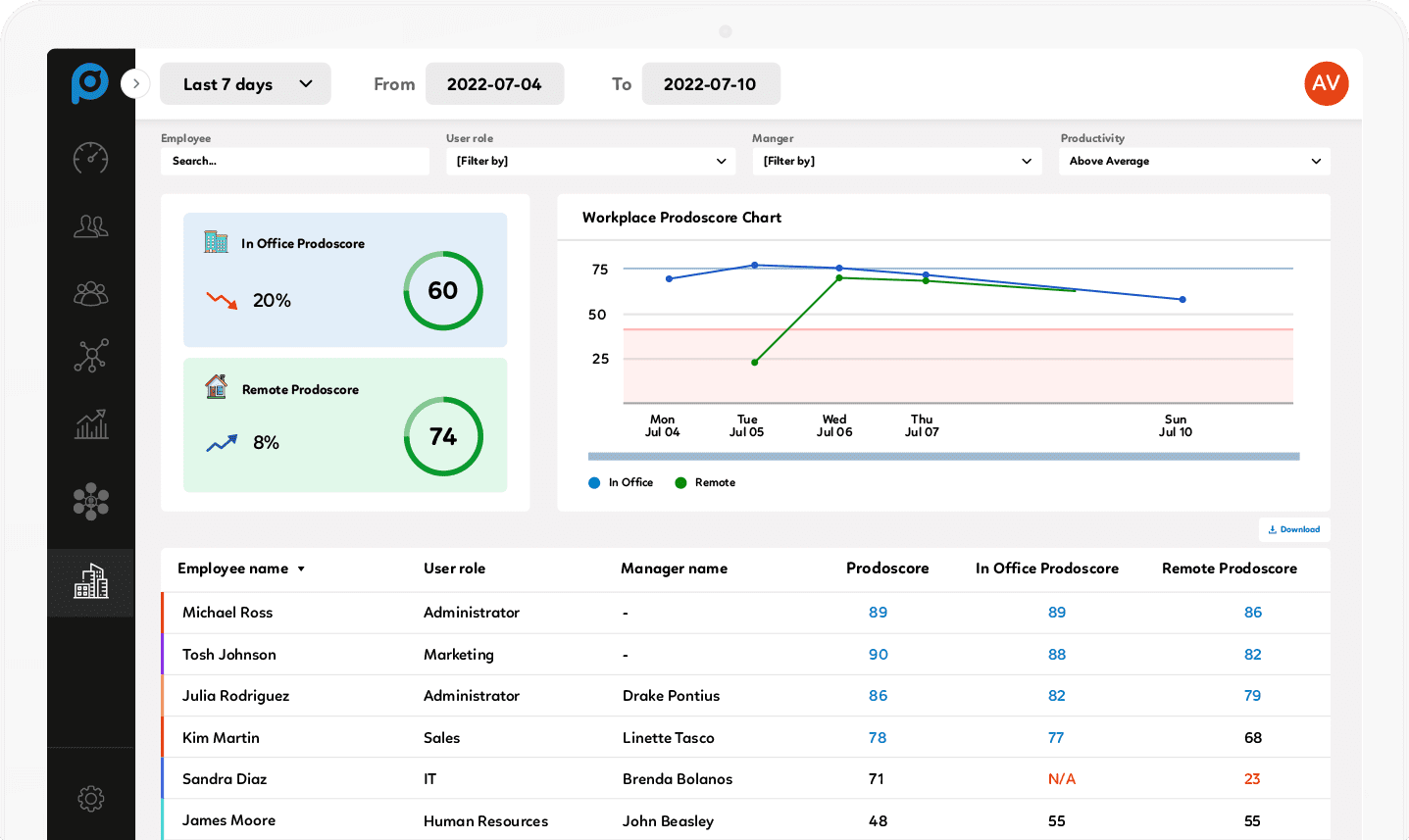Visibility that Creates Value
5 Valuable Insights for Sales Teams from Prodoscore’s Employee Productivity Monitoring Solution
Prodoscore surfaces rich data analytics and insights that provide a blueprint for ideal employee behavior and ROI. Our goal is always to gain a better understanding of how teams operate, and the knowledge gained has helped leadership teams improve employee productivity, efficiency and engagement. Prodoscore data is very well aligned with sales teams, surfacing leading indicators that can help boost productivity and ultimately sales success.
This eBook highlights 5 key insights uncovered in the first few months of Prodoscore being implemented across various sales departments.
What We’ve Learned:
- Business Owners Work Harder
- CRM & Business Phone Systems not Being Used Effectively
- Salespeople are Frequently Off Message
- A Lot Of “Dead Activity” During The Day
- Gaming of Business Reporting Systems Exists
As a general observation, we find that every company using Prodoscore ALWAYS learns something new. Sometimes that revelation is further clarification on what activities are being performed or how time is spent, but for most of our customers, a “new” truth is revealed about how teams work together and maintain productivity. Read on for your lightbulb moment.

Business Owners Work Harder
While this is a conclusion you would expect, what is interesting and quite revealing is how pronounced this behavior is (and, how consistently it occurs). The work ethic of a business owner compared to that of other employees at a company shows almost a 20% improvement in productivity. Owners really do work harder, put in more time, and are a big driving force for the level of success a business achieves. As a takeaway, if you can find a way to work with a business owner – do it!

CRM & Phone Systems Have Very Low Adoption Rates
Another observation that comes through loud and clear is that, while every salesperson complains at some level about time wasted inputting data into CRM systems, most executives and sales leaders believe their teams are doing it. The overall consensus is that a CRM provides a reasonably accurate picture of the current sales pipeline. But the truth is, CRM systems are vastly underutilized. Many activities never get tracked, the sales status of specific deals is often out-of-date, and key new opportunities are seldom entered until late in the process. Part of these findings can be attributed to the uncertain nature of sales – no one wants to look bad for losing a deal. However, another key factor is the time and effort required to update a CRM. Organizations that automate this activity are found to have a much higher quantity and quality of sales opportunity updates.
Interestingly, Prodoscore data shows that C player sales reps are more likely to use CRMs, likely as a way to feign busyness while top sales reps are less inclined to input their updates.
Similar patterns can be seen when VOIP systems are deployed. As validated by a research report by Jon Arnold & Associates, less than 10% of the companies that use a business phone system with mobile support actually see utilization, let alone productivity gains. Integration between communication systems is often challenging – it also requires changing how people work and possibly learning a new application. As a result, usage rarely leads to increased adoption, despite the best intentions.
But, when Prodoscore is deployed, we see adoption rates increase up to 300%*.

*Based on 2021 study comparing adoption pre and post Prodoscore implementation for RingCentral, Microsoft Teams and Google Meets.
Sales People Are Frequently Off Message
Product and service mix are an important part of executing a sales strategy. Yet, when it comes down to what is actually presented during a sales call or an email exchange, messaging doesn’t always align with the leadership team’s direction or overarching brand message. Perhaps there are training gaps or miscommunication or maybe there are legitimate concerns about the product or service. Sometimes sales people are reluctant to shift gears and push new products or services, especially if the new offerings extend beyond their comfort zone. Whatever the reason, a lack of consistency in messaging only hurts your brand and limits growth. With insights from Prodoscore, understanding team messaging and providing guidance is easy.

Surprising Level of “DEAD” Activity During the Day
No one expects employees to perform like robots, being productive every hour of the work day. In fact, studies suggest that a “burst” strategy of working 90 to 120 minutes at a time followed by a 10- or 15-minute break is the optimal way to maximize output for most jobs. What we observe, however, is that some members of sales team have an OPPOSITE interpretation of this productivity research. These employees only put in about 10-15 minutes of high-intensity work followed by a 2-hour downtime. This extreme behavior is a bit alarming for some of our clients – to say the least!
 This finding could suggest why companies are often reluctant to allow employees to work remotely. A common perception is that if given the opportunity to work with greater autonomy, some employees will take advantage. Here is where the value of remote visibility can really pay off. Solution providers like Prodoscore offer ways to address this concern quite effectively, and we actually find that most remote employees are engaged throughout the day.
This finding could suggest why companies are often reluctant to allow employees to work remotely. A common perception is that if given the opportunity to work with greater autonomy, some employees will take advantage. Here is where the value of remote visibility can really pay off. Solution providers like Prodoscore offer ways to address this concern quite effectively, and we actually find that most remote employees are engaged throughout the day.

Some Gaming of Business Reporting Systems Exist
As a final observation, there are a few instances where salespeople are aware that their business activity is being tracked. Bogus entries are recorded to make it appear they are busier than reality. In one example, Prodoscore’s ability to synchronize calendar appointments with voice call activity (be it on a desk or mobile phone) led to identifying when an inconsistency occurred. Of course, some of these instances might be appointments made with the best of intentions, only to have the other caller not be available. But there was at least one instance where we found this activity to occur with far greater frequency.
What will you discover with Prodoscore?
Schedule a free demo with our team today and see the difference an employee productivity monitoring tool like Prodoscore can make for your company.



